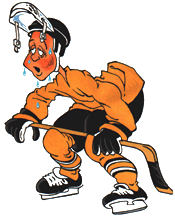HOCKEY 101: Training Drills
Off-Ice Conditioning
by Wayne Gretzky
 A range of muscles are used when players skate, stop suddenly, change directions, and skate backwards. As a result, players should include flexibility exercises each time they prepare to take to the ice and before they train. Stretching will help increase range of motion, make a player quicker, and prevent injuries.
A range of muscles are used when players skate, stop suddenly, change directions, and skate backwards. As a result, players should include flexibility exercises each time they prepare to take to the ice and before they train. Stretching will help increase range of motion, make a player quicker, and prevent injuries.
Be sure to stretch all major muscle groups including thighs, hamstrings, groin, chest, triceps and back. Don't forget basics such as stretching each arm across your back, pulling your triceps across your chest and seated stretches. Repeat as many times as you feel comfortable (usually counts of 10-20 seconds with a few reps is desirable).
Aerobic Training
With a strong base of aerobic endurance, you'll be able to last longer without feeling winded. A healthy cardiovascular system is necessary for long stretches on the ice. You'll be able to stay stronger and last longer in your shift and the game as a whole. To get optimal benefit, try exercising for 30-60 minutes at a time five times a week off-season and twice a week in season, in addition to games and practice.
Depending on your preference, use this time to run, power walk, stairclimb or bike in order to improve aerobic endurance. If time permits, incorporate this routine during the season when you're off the ice.
Speed and Agility Training
Speed and quickness drills will provide you with the bursts of energy you need in a game. Depending on your hockey position, you may want to train by concentrating on the specific muscles you'll be using. Forwards need great wrist mobility for shots and strong, agile legs to do lots of skating. Defensive players need quick hands for fake checking and strength for body checking and to maintain position, as do goalies to quickly block shots.
A great agility builder is to run hill or stair sprints. Depending on your age and level of fitness, choose an incline you can handle but still consider a challenge. Do a maximum of 10-15 strides. If you're a younger or beginner athlete, use a flat or gradual incline and do fewer strides.
Running sprints on an outdoor field or gym can greatly increase your speed on the ice. If you're a young player or beginner, run 30- to 60-second sprints, repeating this 4-6 times. Gradually increase the time and intervals as you train. An experienced athlete or player can work up to 60-90 second sprints, repeating this 6-8 times.
Off-Ice Training Elements
There are a number of principles that you shouldn't forget when you train. Without them, you can't establish a consistent program. Remember to:
--Be aware of your pace and duration. If you want to work all of your muscles effectively throughout your training exercises, you must start off training with a low to average pace, and increase it from there. Challenge yourself, but don't overdo it, so that you hurt yourself.
--Rest intervals are mandatory. You need rest equal to double the work time in order to have enough energy to perform your desired amount of repetitions.
--Training frequency is something you should establish and stick to as consistently as possible. Your endurance, agility and speed will not improve if you don't stick to a regular program. If you want to see results during the season, you have to put in the time off the ice.
« Back to Hockey 101

